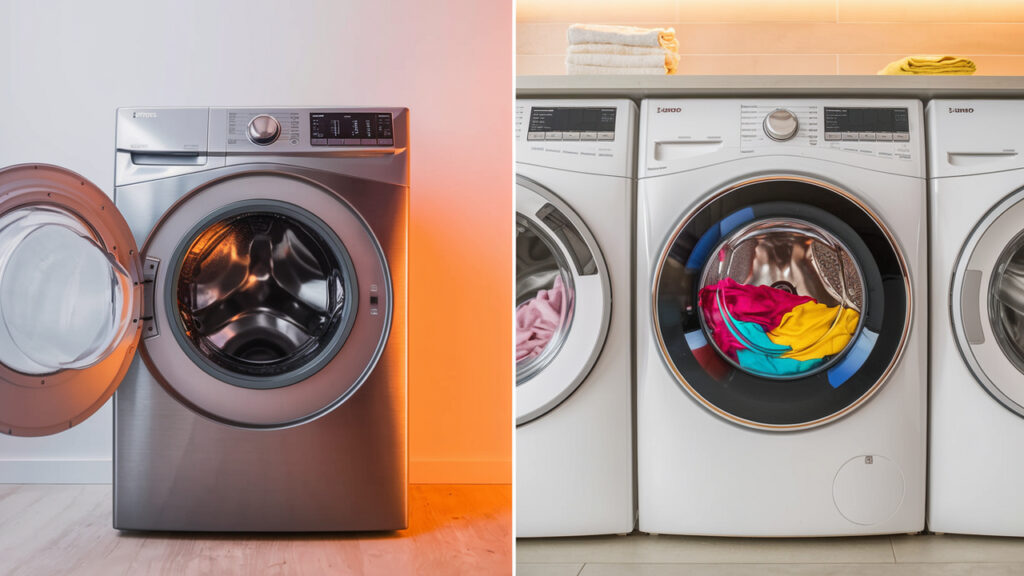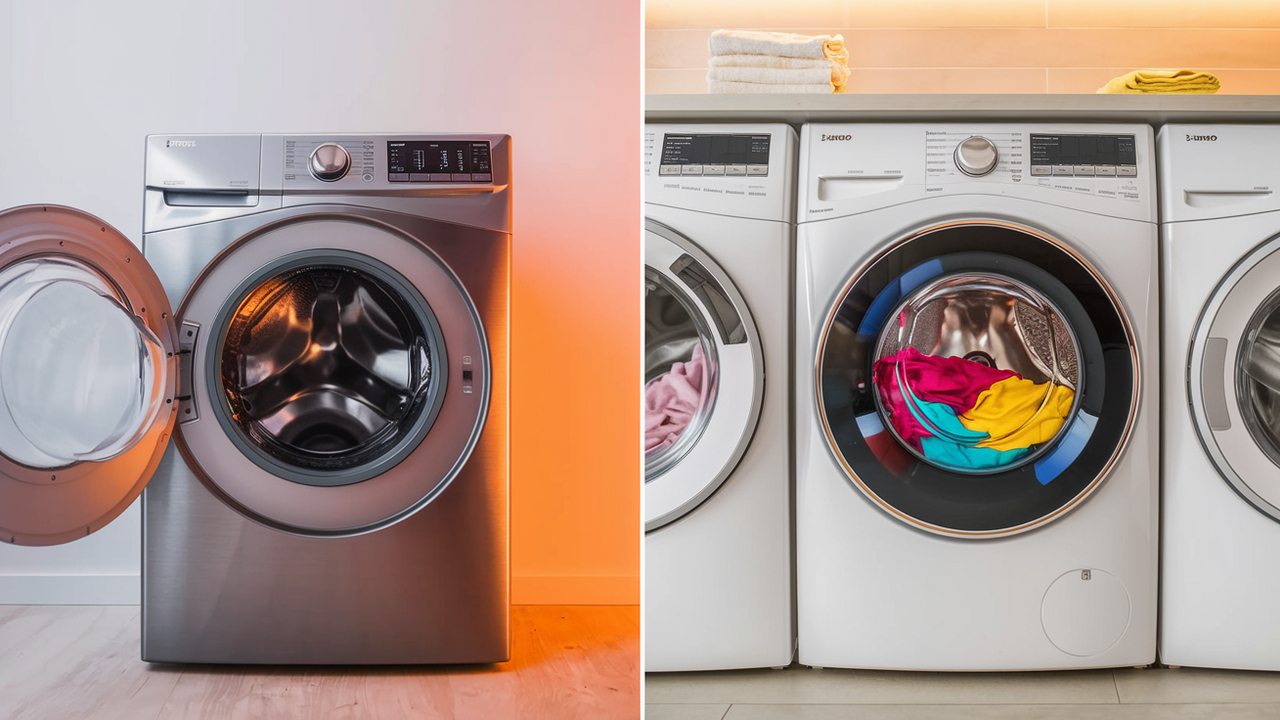Top Load Washers vs Front Load: Which One Is Better for Your Home?
Confused between top load and front load washers? I’ve owned both—and here’s a full breakdown of the pros, cons, and what you really need to know before you buy.
Why I Created This Comparison Guide
Let me be honest—I’ve used both top load and front load washers, and each one has its strengths. When I was shopping for a new washer, I wished someone would just give me a simple, honest breakdown based on real experience. That’s what I’m doing here.
Whether you live in a house, condo, or apartment, choosing the right style affects your daily life more than you think. Noise, space, water usage, and even your back pain—all of that plays a role. So let’s get into it.

Table of Contents
Top Load Washers: Pros and Cons
Pros:
- Easier to load — no bending over
- Can pause mid-cycle to add clothes
- Faster cycles on average
- Generally cheaper up front
- Less mildew risk due to top opening
Cons:
- May use more water (unless it’s HE)
- Tougher on clothes with agitators
- Takes more vertical space
👉 View Top Load Washers on Amazon
Front Load Washers: Pros and Cons
Pros:
- Use less water and energy overall
- Gentler on clothes — no agitator
- Can be stacked with a dryer to save space
- Higher spin speeds = faster drying
- Sleek, modern look
Cons:
- More expensive up front
- Can develop musty odor if not cleaned
- Harder to reach without pedestals
- Can’t open once cycle starts
👉 View Front Load Washers on Amazon
Which One Is Better for You?
If you have back issues, or prefer simplicity, go with a top load washer. They’re easier to use, generally cheaper, and more forgiving if you forget to toss something in after starting the cycle.
If you’re focused on saving water, have limited floor space, or prefer gentle care for your clothes, a front load washer is the winner. I loved mine when I was living in a small apartment and needed to stack the dryer on top.
What I Personally Use and Why
Right now, I’m using a top load high-efficiency washer. For my household, the faster wash time, larger capacity, and easy access made more sense. I also got tired of dealing with front load mold issues, especially since I don’t always remember to keep the door open after each wash.
That said, when I lived alone in a small place and didn’t do much laundry, the front load washer was a dream. Quiet, efficient, and stylish—it got the job done with less water and looked great in my space.
Extra to Help You Decide Confidently
Top load washers are usually more affordable, especially when you factor in installation. Most don’t need pedestals, which can cost an extra $200+ per unit for front load setups.
If you’re washing large comforters or blankets often, top load washers with deep tubs tend to give more space to move heavy items around—just make sure the agitator isn’t too aggressive.
Front load washers are better at handling delicate fabrics like silk, lingerie, or baby clothes. They clean by tumbling, not agitation, so they extend the lifespan of certain clothing.
People with tight laundry closets or limited square footage often choose front load washers because they can be stacked. But if you have overhead shelves or cabinets, top load models may fit better under them.
Water usage matters if you’re in an area with high utility costs or drought restrictions. Most front loaders win here, but modern high-efficiency top load washers now use as little as 12-17 gallons per cycle too.
Another thing to consider is wash cycle flexibility. Some top load washers now offer customizable modes like deep fill, quick wash, and allergen cycles. Front loaders often have more preset cycles, which is good for ease but can limit manual control.
The maintenance is different too. Front load washers need more frequent cleaning to avoid mildew buildup around the rubber gasket. Top loaders don’t have that problem, but still benefit from a monthly cleaning cycle.
Vibration and noise are also worth thinking about. Older top load washers used to shake like crazy. But today’s models with inverter motors or anti-vibration tech are almost as quiet as front loaders.
Got pets? A few top load washers now come with pet hair filters or deep rinse options—something that’s hard to find in front load machines.
Another plus for top loaders is you can soak clothes right in the drum. This is handy for pre-treating stained kids’ clothes, gym wear, or work uniforms before running the main wash.
For multi-taskers, top loaders that offer smart connectivity or Load & Go™ dispensers are great time-savers. Fill detergent once, start cycles remotely, and never forget a load again.
If budget is a concern, stick with top load models under $700. You’ll still get modern features like HE performance and delay start, without going overboard.
Whichever you choose, make sure it aligns with your laundry habits, living space, and budget. You’ll be using it for years, so it’s worth getting it right the first time.
If you live in a multi-story home or on a second floor, keep in mind that front load washers can be heavier and might require vibration pads or reinforced floors. Top loaders are usually lighter, making them a bit easier to manage during moves or installations.
Some people forget to think about resale value or future tenants. If you’re planning to sell your home or rent it out, having a modern front load washer may appeal more to younger buyers or renters looking for that sleek, stacked look. But if you’re aiming for long-lasting durability and fewer repairs, top load washers often outlast their front-load counterparts.
One thing I’ve noticed after years of doing laundry is that kids and older adults often find top loaders easier to operate. The controls are simple, and the opening isn’t blocked by the washer door. This can be a huge plus for families or multi-generational households.
Also, when it comes to odor control, top loaders have the upper hand. You can leave the lid open between washes without the space looking cluttered. That airflow prevents mildew from forming, which is a common issue with front loaders that stay closed most of the time.
At the end of the day, you have to go with what works best for your lifestyle. I’ve gone through both styles, and there’s no “one-size-fits-all” answer. If convenience, capacity, and low maintenance are your priorities—top load might be your winner. But if water efficiency, stackability, and gentle washing matter more—front load could be the better fit.

